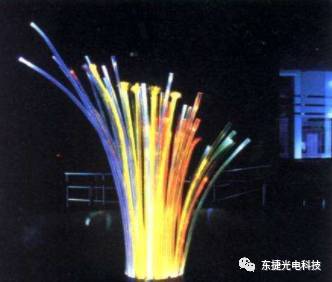With the development of science and technology, people's life style has changed greatly in communication, from the original radio communication to the wired communication, and now to the optical communication. Optical communication is widely used because of its advantages such as wide frequency bandwidth, large communication capacity, low transmission loss and long relay distance. So how exactly does optical communication come true?
First realization of optical communication in history
In the history of communication, Popov sent and received the first wireless telegraph in 1896, and Baer, who was famous for inventing the telephone, invented the telephone in 1876, and thought about the problem of using light to make telephone calls. In 1880, he used sunlight as light source, the atmosphere as the transmission medium, and selenium crystal as the optical receiving device, successfully carried out the experiment of optical telephone, the distance reached 213 meters farthest.

Light phone experiment, Baer used the arc lamp or the sun as light source, light beam through the lens focused on the microphone vibration film. When the speaker speaks to the microphone, the vibrating piece changes with the voice, and the intensity of the reflected light changes with the intensity of the voice, so that the voice information is "loaded" on the light wave (this process is called modulation). At the receiver, a parabolic receiver mirror is used to reflect the light transmitted from the atmosphere to the silicon photocell. The silicon photocell converts the light energy into the current (the process is called demodulation). The current is sent to the receiver, and the sound from the transmitter can be heard.
However, the optical communication provided by Baer is more demanding for the environment. During the propagation process, reliable and continuous light sources and stable air medium seriously affect the transmission of optical information. In order to communicate with light, two fundamental problems must be solved: one is to have stable and low loss transmission medium; the other is to find a high strength and reliable light source. In the following decades, there has been no new progress in optical communications due to the fact that the two key technologies have not been solved.
Laboratory coincidences promote the emergence of the most important device in optical communications
The law that light travels in straight lines is that the small hole imaging experiment designed by Zhao Youqin, an astronomer and mathematician in the Yuan Dynasty in the early fourteenth Century, has been rigorously verified. In 1870, Tindall, a British physicist, observed that light travels along curves. In one experiment, the light was irradiated into the container of water, and the water flowing out of the water outlet, the light also spread along the water, bending phenomenon, which does not seem to conform to the law that light can only propagate straight. But also found that light transmission along fine down ejected from the barrel of the light, also along the curved glass rod. Why is that? Is the light no longer straight? This phenomenon has aroused the attention of the Tyndall, through his research, found that this is the whole reflection of light, which is due to water due to medium density than the surrounding material (such as air), light from the water to the air strike, when the incident angle is greater than a certain angle, light disappears, all the light reflected back into the water.

Later, people made a kind of glass fiber with high transparency and thick spider like silk. When the light rays were injected into the glass fiber at a proper angle, the light went along the winding glass fiber. This is the prototype of optical fiber. Later in 1966, the British and Chinese scholars Dr. Gao Kun (K.C.Kao) in the PIEE magazine published "the frequency of light medium waveguide fiber surface", it is proved that using optical fiber as the transmission medium to realize the possibility of optical communication, and predicted the possibility of making communication with the ultra low fiber. Since then, the door to the world of optical communications has been completely pushed aside.
Principles of optical communication
In fact, optical communication is a way to realize communication with light as the information carrier. At present, due to the limitations of science and technology, our information mainly exists in the form of electrical signals. In the realization of optical communication, we should first convert the electrical signals into optical signals, and then transmit the optical signals to the electrical signals through the optical fiber cable transmission, so as to achieve the purpose of information transmission.

The most basic optical fiber communication system consists of data source, optical transmitter, optical channel and optical receiver.
The data sources include all the signal sources, they signal by voice, image and data services after source encoding; optical transmitter and modulator is responsible for the signal into optical signal suitable for transmission on optical fiber, optical fiber transmission because of the light in the different attenuation characteristics of different transmission light wave window screening. Currently used with a 0.85 m, 1.31 m and 1.55 m; optical fiber channel including the most basic, and relay amplifier EDFA; optical receiver is used for receiving the optical signal, and extract information from, and then converted into electrical signals, and finally get the corresponding voice, image, data and other information.
Status quo of optical communication
Based on the advantages of optical communication frequency bandwidth, large communication capacity, low transmission loss and long relay distance, the ultimate goal of future transmission network is to build all optical networks. In the access network, metropolitan area network and backbone network, "fiber transmission" is used instead of copper wire transmission".

Among them, the backbone of speed, distance and capacity requirements of the highest part of the network, the basic idea is the introduction of the intelligent control plane in the optical transmission network in the past, in order to achieve the resource distribution according to need; and the man will become the operator to provide bandwidth and service and the bottle neck, at the same time, man will as the largest market opportunity; on the access network, FTTH (FTTH) is a long-term ideal solution. The evolution of FTTx will gradually push the fiber closer to the user, that is, from FTTN (fiber to cell) to FTTC (fiber to the road) and FTTB (fiber to the apartment building), and finally to FTTP (fiber to the station), of course, this will be a very long transition period.
Backbone network and metropolitan area network have basically realized the whole photochemistry, and some areas with fast network development have realized the partial optical access of the access layer.
Today, optical communication technology has been very mature, optical fiber communication is the main transmission mode of all kinds of communication network, optical fiber communication plays a vital role in the construction of information superhighway. Our country in optical communication, thanks to the triple play, speed drop charges and a series of policies to increase the demand of optical communication equipment, with broadband Chinese strategy to promote the process of the three major domestic telecom operators to accelerate the pace of construction of city network, China communication industry has shown a trend of rapid growth.



